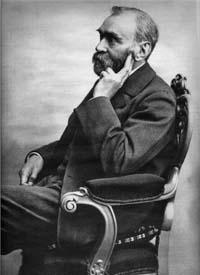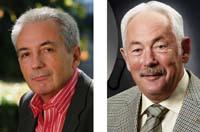In the main Nobel laureates

However, in other areas they have also been scientific issues. In fact, the Nobel Peace Prize (along with Al Gore) will be awarded to the organization responsible for climate change (IPCC) for warning of the risks posed by climate change and proposing measures to combat it.
On the other hand, the Nobel Prize in Economics. In fact, the prize was not created by Alfred Nobel himself, but was created in 1968 by the Bank of Sweden in homage to Alfred Nobel and communicates with the rest (specifically, on Monday the following week). This year, Leonid Hurwicz, Eric S. Maskin and Roger B. The winners are Myerson and will receive the Nobel Prize for their contributions to the development of the theory of the design of mechanisms. Mathematics has been an indispensable tool for developing this theory.
And it is necessary to mention the Nobel Prize in Literature. Well, the winner is Doris Lessing, author of science fiction novels. Therefore, scientific issues have been the main ones at the 2007 Nobel Laureates.
Mouse models at the Nobel Prize in Physiology or Medicine

Mario C. Capecchi, Martin J. Evans and Oliver Smithies
"for the findings they have made in the mouse to cause certain genetic changes using stem cells"
Three researchers have made key findings to develop the technique of making models of genetically modified mice. These mice usually have some inactivated gene (knockout mice) and are able to transmit that genetic change to their descendants. Biomedicine is of great importance, as it is a very useful tool in both basic research and research of new therapies.
Recombination to change genes
When Capecchi and Smithies started working, it seemed almost impossible for mouse DNA to undergo desired genetic changes. But both researchers thought the key could be in recombination. In the cell distribution there is an exchange of genetic information in each pair of chromosomes, that is, they are recombined. Capecchi and Smithies suspect that recombination could be used to modify certain genes and studied it to do so.
Capecchi demonstrated that between foreign DNA and chromosomes a recombination could occur in mammalian cells, among other things he demonstrated that defective genes could be repaired by externally introduced DNA. Smithies, for his part, tried to solve the mutated genes. In these trials he found that all genes can cause changes by recombination.
Stem cells, starting point
The first cells studied by Capecchi and Smithies were not suitable for forming mouse lineages with inactivated genes. They needed another type of cell capable of transmitting to future generations the changes produced in DNA. Reproductive cells, sperm, and eggs are the only cells capable of doing so.

Martin Evans discovered that the stem cells of mouse embryos could be appropriate to introduce genetic material into the reproductive cells and, from there, developed the technique of creating mice (knockout mice) with certain inactive genes.
In 1989 the first research was published in which the mouse is mentioned with an inactive gene for recombination with embryonic stem cells. Since then they have created many types of mouse of this type that allow to investigate any aspect of the physiology of mammals, from the development of the embryo to serious diseases. They are also used to investigate the effect of gene therapy.
Small hard drives at the Nobel Prize in Physics

Albert 978-84-y Peter Grünberg
"To discover a giant magnetoresistance"
This year's Nobel Prize in Physics will be awarded to those who have developed the data reading technology used on hard drives. This technology has allowed hard drives to be drastically reduced in recent years.
In 1988, Ferte and Grünberg, each in turn, discovered a completely new physical phenomenon: giant magnetoresistance (or GMR). A system based on the magnetic gigantesistence transforms the small magnetic changes of the hard disks in the change of electrical resistance, that is, the values 1 and 0 used in digital systems. This phenomenon occurs in fine magnetic materials that only have a thickness of a few atoms.
More sensitive readers
Fine materials have made laptops, music players, etc. become smaller and smaller. In these systems the information is very packaged on hard drives. Information is stored as a microscopic space that is magnetized in different directions.

Readers of these devices analyze the disks and record the changes of magnetism in them. The more compact the hard drive, the smaller and weaker the magnetic spaces will be. Readers in these areas should therefore be very sensitive. A reader head based on the effect of gigantesistencia magnetic is able to detect these small magnetic changes and turn them into a change of electrical resistance.
The thinner the layers of the reader, the greater the compaction of the information of the hard disks, since the layers will be able to modify their magnetization according to these small variations of magnetization.
Readers alternately have thin layers of a magnetic and non-magnetic material. If the magnetism of a magnetic layer is fixed and variable to the next, the magnetization of the latter may vary depending on the magnetization of the space that studies or reads on the hard disk. Depending on the reading area, the magnetizations of the two magnetic layers of the reader will have the same meaning or opposite direction, so the magnetic resistance will be high or low.
This year, therefore, they reward those who have invented a technology that has made it possible to read the information of small hard drives.
Solid surface reactions at the Nobel Prize in Chemistry

Gerhard Ertl
"For researching chemical processes on solid surfaces"
If a solid participates in a chemical reaction, it will be located on the outside of the solid, on the surface. Sometimes the solid itself reacts and, other times, binds the molecules that must react to the reaction between them, in which case we call catalyst. However, there are many reactions on the surface of the solid. For example, a piece of iron begins to oxidize from the outside, as only the iron atoms on the surface can be in contact with oxygen from the air. Although solid is dust, the reaction occurs on the surface of dust grains.
The fact that it occurs on a surface provides special characteristics to chemical reactions and are very difficult to investigate. On the one hand, very clean and regular surfaces are required, and on the other, very precise techniques to study the dynamics of molecules approaching the surface. It is in this area that the German chemist Gerhard Ertl acquired relevance. He developed the most widely used methodology for the research of chemical reactions in solids. This methodology has become a common practice in both research laboratories and industry.
Air nitrogen
Ertl investigated a typical process of the chemical fertilizer industry, the Haber-Bosch reaction, which transforms nitrogen into the air, reacting with hydrogen, into ammonia. For this it is necessary to use solid iron. It acts as a catalyst because nitrogen and hydrogen molecules must be adsorbed in iron to react to each other. If not, they do not react.

Ertle described step by step how this process occurs: how nitrogen is adsorbed to iron, how hydrogen is adsorbed and how adsorbed atoms react. In addition, he described the dynamics of hydrogen not only with iron, but also with platinum, nickel and palladium.
However, the importance of Ertl is not limited to the Haber-Bosch reaction. His methodology combined theoretical modelling of molecules, advanced spectroscopic techniques and many laboratory procedures to highlight what was happening on the surface. These techniques have allowed to investigate many other solid processes, such as the semiconductor industry (electronics industry), fuel combustion optimization (automotive), etc. in a long etcetera.





